

Weather on Other Planets: Atmospheric Conditions & Temperature. SSI - Kinesthetic Astronomy. Here we present a significant upgrade to the first in a series of innovative, experiential lessons we call Kinesthetic Astronomy.

The Sky Time lesson reconnects students with the astronomical meaning of the day, year, and seasons. Like all Kinesthetic Astronomy lessons, it teaches basic astronomical concepts through choreographed bodily movements and positions that provide educational sensory experiences. Kinesthetic Astronomy lessons are science-rich and fun. They are intended for sixth graders up through adult learners in both formal and informal educational settings. They emphasize astronomical concepts and phenomenon that people can readily encounter in their "everyday" lives such as time, seasons, and sky motions of the Sun, Moon, stars, and planets. Kinesthetic Astronomy lesson plans are fully aligned with national science education standards, both in content and instructional practice. Fifth grade Lesson The Location of Earth. Inquiry Based Instructional Model To intertwine scientific knowledge and practices and to empower students to learn through exploration, it is essential for scientific inquiry to be embedded in science education.
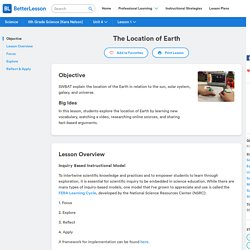
While there are many types of inquiry-based models, one model that I've grown to appreciate and use is called the FERA Learning Cycle, developed by the National Science Resources Center (NSRC): Tree Identification - NEXT.cc. Draw three diagrams of a tree.
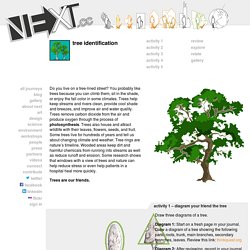
Diagram 1: Start on a fresh page in your journal. Draw a diagram of a tree showing the following parts: roots, trunk, main branches, secondary branches, leaves. Review this link: thinkquest.org Diagram 2: After reviewing, record in your journal the following shapes of trees: Columnar, pyramidal, v-shaped, round, oval, weeping. First draw the natural shape of the tree in pencil, and then draw the geometric figure of the tree in marker. Diagram 3: Draw a cross section of a tree trunk after reviewing the Life of a Tree at: Label the outer bark, inner bark, the cambium, sapwood, and heartwood layers. April 2017: My Favorite NGSS Freebies — Juli Cannon Science.
Using Data - Scientific PracticesGet your students to analyze quantitative data and make claims based on evidence by using authentic data provided by Data Nuggets.
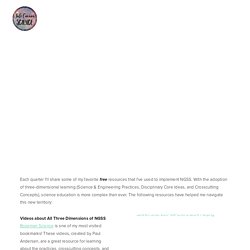
These engaging activities show how real scientists complete research by including data and videos of their experiments. Activities are ranked from a difficulty of 1 (elementary+) to 4 (college). If that wasn't enough, each activity is differentiated so that students can either analyze graphs that are already provided or creating their own from a set of data. Problem-Based Engineering UnitsI don't know about you, but before the adoption of NGSS, I never imagined that my 5th graders would be doing something as rigorous as designing a biopolymer to be used as an alternative to plastics, but that's exactly the type of project that this resource provides.
The Teaching Channel has partnered with Boeing to create problem-based engineering modules. This lesson plan looks at Animals and their Adaptations to the environment. Title – Designer Animal – Animal Adaptations By – Rachael Kerr Primary Subject – Science Secondary Subjects – Science Grade Level – 5 – 8 This is a useful lesson for teaching animal adaptations.
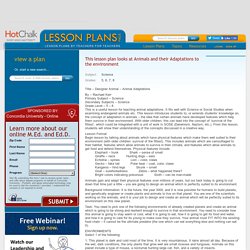
It fits well with Science or Social Studies when examining endangered animals etc. This lesson introduces students to, or extends students’ knowledge on, the concept of adaptation in animals – the idea that certain animals have developed features which help them survive in their environment. With older children, this can lead into the concept of ‘survival of the fittest’, which could be integrated with a unit of work in SOSE (Darwinism, Nazism, etc.). From this lesson, students will show their understanding of the concepts discussed in a creative way. Lesson Format Begin lesson by talking about animals which have physical features which make them well suited to their environment (with older children: survival of the fittest).
ENVIRONMENTS Select 1 of the following: 3. 4. Assessment. The Science Spot. Access Excellence Collection - This site offers a wide range of lessons and activities as well as a graphics gallery.

Biology Corner Lesson Plans - Visit this site for lessons related to cell biology and genetics as well as other great ideas. CFAITC.org - Where'd you get those genes? (pdf) - Download this activity book to browse the lessons ideas for your genetics unit! The site also offers a From Genes to Jeans (pdf) activity book to explore genetic research. Science & Math Investigative Learning Experiences.
NGSS. 5th Grade Science Curriculum Map. Fifth Grade - Park Hill School District. 5th Grade Topic Model. The 5th Grade Performance Expectations (PEs) are organized into four different bundles of PEs in this model, using a topical arrangement.
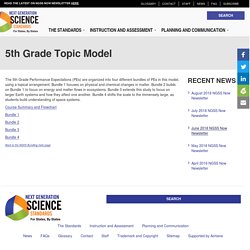
Bundle 1 focuses on physical and chemical changes in matter. Bundle 2 builds on Bundle 1 to focus on energy and matter flows in ecosystems. Bundle 3 extends this study to focus on larger Earth systems and how they affect one another. Bundle 4 shifts the scale to the immensely large, as students build understanding of space systems. Course Summary and Flowchart Bundle 1 Bundle 2 Bundle 3 Bundle 4 Back to the NGSS Bundling main page. Science - 5th Grade Core. Science & Math Investigative Learning Experiences. Science & Math Investigative Learning Experiences.